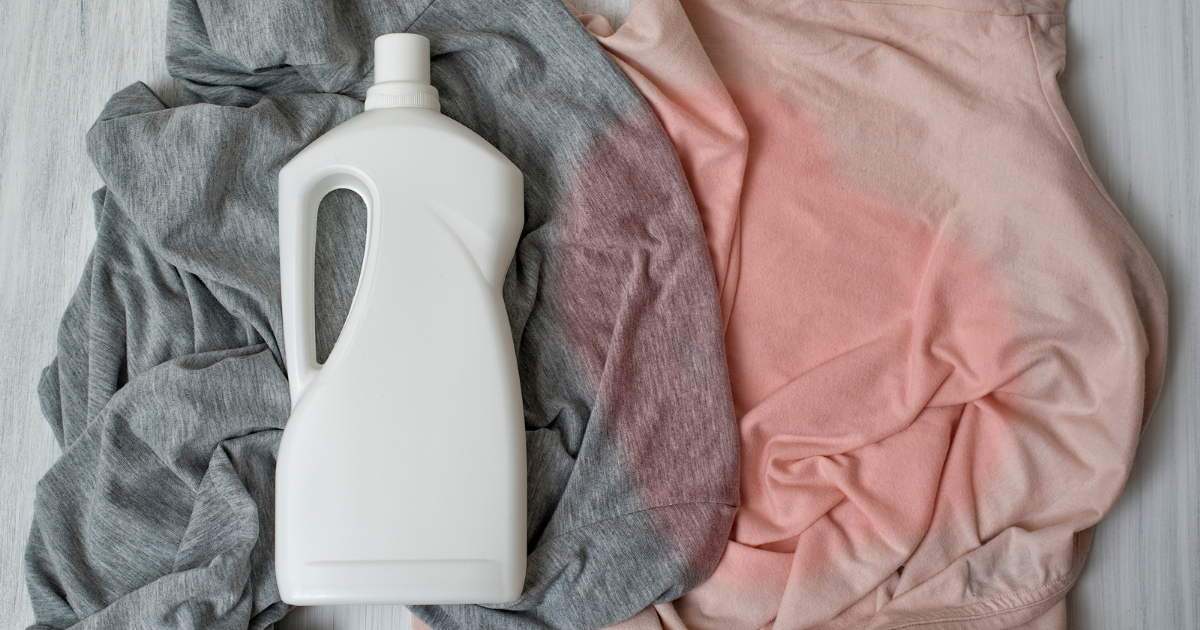Picture this: you’ve spent hours meticulously sorting your laundry, separating delicate silks from sturdy cottons, whites from colors. You’re confident your whites will stay bright and your vibrant hues will stay put. But then, disaster strikes. One little red sock, accidentally mixed in with your white load, bleeds its color onto everything else, leaving you with a rainbow of pink and a sinking feeling in your stomach.

Image: tidydiary.com
This common laundry nightmare is a familiar experience for many. Color bleeding, the phenomenon where dye from one piece of fabric transfers to another, can be frustrating and costly. Luckily, there’s a simple and effective solution that’s been used for generations: vinegar. Vinegar’s ability to set dye and neutralize alkalinity makes it a powerful weapon in the fight against color bleeding.
Understanding the Basics of Color Bleeding
Before diving into the vinegar solutions, let’s delve into the science behind color bleeding. Fabrics are dyed using pigments that are either water-soluble or oil-soluble. When these pigments come into contact with water, they can detach from the fabric and become free-floating in the wash water. This loose dye then attaches itself to other fabrics, leading to the dreaded color bleeding effect.
Factors that contribute to color bleeding include:
- Type of Dye: Certain dyes, especially those used for bright or dark colors, are more prone to bleeding.
- Fabric Quality: Lower-quality fabrics with loosely woven fibers are more likely to release dye.
- Water Temperature: Hot water encourages dye to loosen, increasing the chances of bleeding.
- Overloading the Washing Machine: Insufficient space for clothes to move freely in the washer can lead to increased friction and dye transfer.
The Magic of Vinegar in Laundry
Vinegar, a naturally acidic substance, plays a crucial role in preventing color bleeding by setting dyes. When added to the wash cycle, vinegar reacts with the dyes, stabilizing their attachment to the fabric. This reduces the likelihood of dye release and color transfer. Furthermore, vinegar’s acidity counteracts the alkalinity of detergents, which can also contribute to color fading and bleeding.
Vinegar’s Laundry Power: A Step-by-Step Guide
Ready to put vinegar’s color-fighting power to the test? Follow these simple steps for a laundry experience that’s stain-free and color-true:
- Pre-treat New Items: Before washing new garments, especially those in bold colors, pre-soak them in a vinegar solution for 30 minutes. This helps to set the dye and prevent bleeding during the first wash. Combine a cup of white vinegar with a gallon of cool water in a basin. Submerge the garments in the solution and let them soak. Rinse thoroughly before washing as usual.
- Add Vinegar to the Wash Cycle: For regular laundry, add half a cup of white vinegar to the fabric softener dispenser of your washing machine. The vinegar will be released during the rinse cycle, setting dyes and reducing color bleeding.
- Cold Water Wash: When possible, wash color-prone items in cold water. Cold water helps to minimize dye release and prevent bleeding. Hot water can loosen the dyes and increase the chance of color transfer.
- Line Dry or Tumble Dry Low: After washing, line-drying your clothes can help prevent color fading and bleeding. If using a dryer, set it to low heat. High heat can cause dyes to loosen and transfer.

Image: www.hunker.com
Expert Tips for Preventing Color Bleeding
While vinegar is an effective way to reduce color bleeding, experts also recommend these additional tips for ensuring your clothes stay vibrant and colorfast:
- Separate Dark Colors: Wash dark and bright clothing separately from lighter colors. This minimizes the risk of color transfer between different shades.
- Turn Garments Inside Out: Turning the garment inside out helps to protect the fabric’s exterior from fading and color bleeding.
- Avoid Overloading the Washer: Make sure your washing machine isn’t overloaded, allowing clothes to move freely and reduce friction.
- Always Read Care Labels: Before washing any new clothes, check the care label for specific instructions. Some items may require hand washing or special cleaning methods to prevent color bleeding.
How To Prevent Color Bleeding With Vinegar
Conclusion
Color bleeding is a common laundry problem, but it doesn’t have to be a cause for despair. By leveraging the power of vinegar and following these simple tips, you can protect your clothes and keep your laundry looking vibrant and beautiful. Remember, a little vinegar goes a long way in keeping your wardrobe colorful and free from unexpected color variations. So next time you face the dreaded color bleeding, reach for the vinegar bottle and restore your laundry to its original glory. And don’t forget to share your laundry wisdom with others!






